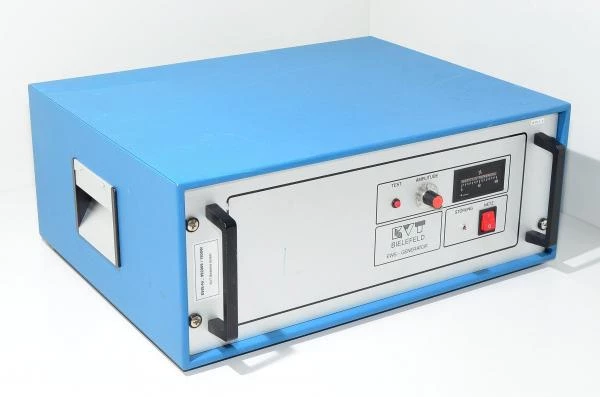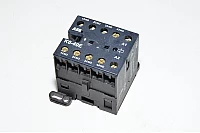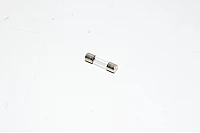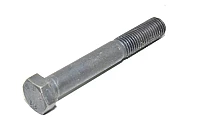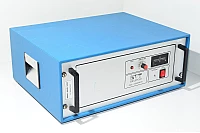KVT Bielefeld ETY 1000 / 35 E (A1500) EWS generator 1500W
- Manufacturer:
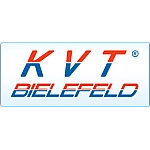
KVT Bielefeld - Model:
KVT Bielefeld ETY 1000 / 35 E (A1500) - Dimension:
420 x 500 x 206 mm - Weight:
18200 g - Availability: 17pcs
- Condition: Used
-
Price Including VAT: 1255€
- Ex Tax: 1000€
In short ERW systems uses the mighty power of induction in order to heat up things via electromagnetic resistance caused by induced eddy currents. Basically ERW machine can be used for heating up various types of metal. This makes it possible to use this appliance when welding various metal parts inside of plastic, including thread inserts and foils. Inductive method offers a possibility of heating the parts contact free.
Explanation of abbreviations, before you lose your thoughts:
- EWS = Elektrowiderstandsschweißen (it's German and means in English Electric resistance welding)
- ERW = Electric resistance welding
ERW system allows user to install inserts very efficiently due to the fact that the thermal energy reaches the surfaces very quickly and without heat loss, thanks to induction principle. Another advantage is a small remaining heat in the welded metal parts, which upon cool-down phase does act as a small post heating feature and therefore relieves the material of nearly all remaining tensions on the joining surfaces. It is also possible to use this process in reverse and extract the parts welded with this same exact process. If compared to ultrasonic welder ERW system has a clear advantage in a form of increased throughput when installing multiple inserts at a time. Ultrasonic system can typically do only one insert at a time or then the tool making complexity grows a lot. Also ultrasonic welder will not work in reverse if the parts needed to be extracted at some point.
In general the whole system consists of Generator (which generates the signal) -> Compensator (which compensates ie matches the converter to the generator and makes sufficient voltage transformation) -> Converter (basically a water cooled induction coil) -> Ceramic tipped ferrite core (which acts as an electromagnetic field guide to the metallic piece in order to induce eddy currents into the workpiece. It also doubles as a ram that pushes the component into it's final resting place). Converter is connected into the compensator with wave tubes. A suitable copper pipe may be used for this purpose as well, but then the while contraption can't really move or vibrate that much. The tubes carry the large current from the compensators transformer into the converter. The tube also delivers the coolant flow for the converter in order to eliminate the risk of coil meltdown. A coolant system is hooked into the compensator in order to dissipate the heat generated by the converter coil.
ERW system benefits:
- Enables fast, safe and high-strength bonds of plastic parts.
- Allows for embedding metal reinforcements in the joining zone, allowing the seam to get an extra rigidity.
- The joining zones of plastic parts can be 3-dimensional
- It is possible to archive welding seam lengths of 3...3000m with standard ERW machines.
- Method is extremely process safe and it can be virtually perfectly monitored and recorded.
- Allows for reversed operation and it can be used for extraction of metal objects from plastic as well.
Application examples:
- Compensators
- Fuel valves and containers
- Air suction tubes for engines of passenger cars
- Oil mist separators and condensation
- Activated charcoal filters and plate air filters
- Water separators
- Housings for loudspeakers and pumps
- Foil packaging and laminated articles
- Household appliances and batteries
- Manufacturing of mobile phones
| ABS (Acrylonitrile butadiene styrene) |
CA, CAB (Cellulose Acetate, Cellulose Acetate Butyrate) |
Ionomer | PA (Polyamide, Nylon) |
PBTP (Polybutylene terephthalate) |
PMMA (Polymethyl methacrylate) |
PB (Polybutylene) |
PC (Polycarbonate) |
PE (Polyethylene) |
PP (Polypropylene) |
PS (Polystyrene) |
PSU (Polysulfone) |
PU (Polyurethane) |
POM (Polyoxymethylene) |
PPO (Polyp-phenylene oxide) |
PVC (Polyvinyl chloride) |
|
| ABS (Acrylonitrile butadiene styrene) |
X | X | X | |||||||||||||
| CA, CAB (Cellulose Acetate, Cellulose Acetate Butyrate) |
X | |||||||||||||||
| Ionomer | X | |||||||||||||||
| PA (Polyamide, Nylon) |
X | |||||||||||||||
| PBTP (Polybutylene terephthalate) |
X | |||||||||||||||
| PMMA (Polymethyl methacrylate) |
X | X | X | X | ||||||||||||
| PB (Polybutylene) |
X | |||||||||||||||
| PC (Polycarbonate) |
X | X | X | X | X | |||||||||||
| PE (Polyethylene) |
X | |||||||||||||||
| PP (Polypropylene) |
X | |||||||||||||||
| PS (Polystyrene) |
X | X | X | X | ||||||||||||
| PSU (Polysulfone) |
X | X | ||||||||||||||
| PU (Polyurethane) |
X | |||||||||||||||
| POM (Polyoxymethylene) |
X | |||||||||||||||
| PPO (Polyp-phenylene oxide) |
X | X | ||||||||||||||
| PVC (Polyvinyl chloride) |
X |
ETY 1000 / 35 E (A1500) EWS generator technical details:
- Rated output:
- 1500W
- Max compensator output current:
- Up to 650A
- Max output voltage:
- 50...300V
- Operating frequency range:
- 15...80kHz
- Typical operating frequency range (as far as we understand the conflicting datasheets):
- 28-35kHz
- Generator output implementation method:
- Thyristor controlled
- Frequency control:
- Automatic
- Power adjustment:
- Infinitely variable between 25...100%
- Operating voltage (input voltage):
- 230VAC
- Overload protection:
- Yes, automatic
- Connections:
- Fixed power cable
- 17pin female connector for cable that goes between generator and compensator
- 5pin 270° DIN male fault/ready relay contacts
- Pin 1 = Relay NO contacts
- Pin 2 = Not connected
- Pin 3 = Relay common pin
- Pin 4 = Not connected
- Pin 5 = Relay NC contact
- Another known model marking:
- EWS generator MF 1500
Download KVT Bielefeld EWS process overview
Download KVT Bielefeld EWS system components MF 1000 - MF 1500 system overview
Download KVT Bielefeld EWS system components technical datasheet
Download KVT Bielefeld system cooler SCE 0.7 V technical datasheet
Tags: eddy current heating, ERW, KVT Bielefeld, induction heater, induction, EWS generator, induction heater station, eddy current, eddy current welding
Recently viewed
Price Inc. Tax: 1255€ Price Ex. Tax: 1000€
Availability: 17

